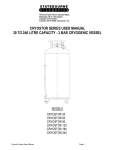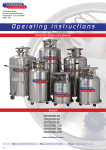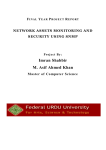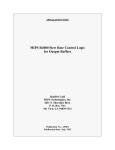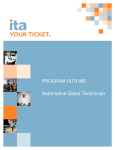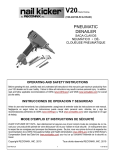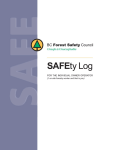Download Manual for Owners and Operators of Special Status Plants Risk
Transcript
BRITISH COLUMBIA SAFETY AUTHORITY Manual for Owners and Operators of Special Status Plants Risk Assessed and General Supervision Date: March 12, 2012 Controlled Document: MAN -4000-03 I TABLE OF CONTENTS SECTION “A” ............................................................................................................................... 3 Introduction .................................................................................................................. 3 General Supervision Staffing Requirements ................................................................ 3 Risk Assessed Status Staffing Requirements.............................................................. 3 Registration Procedure ................................................................................................ 3 General Supervision................................................................................................. 4 Risk Assessed Status .............................................................................................. 4 Process Flow Chart ..................................................................................................... 6 SECTION “B” ............................................................................................................................... 7 Minimum Schedule of Controls .................................................................................... 7 Testing And Maintenance Requirements ..................................................................... 7 Minimum Requirements of Automatic Control Devices for Boilers ............................... 8 Low Water Cut-off Control .................................................................................................................... 8 Minimum Requirements of Automatic Control Devices for Refrigeration Plants .......... 8 High Compressor Discharge Pressure Alarm ...................................................................................... 8 High Level Alarm Suction Trap: Non-Critically-Charged Systems ....................................................... 8 Ammonia Monitoring for Safety ............................................................................................................ 8 Plant Audit Guideline ................................................................................................. 12 Purpose: ............................................................................................................................................. 12 1. Installation ...................................................................................................................................... 12 2. Training Program ........................................................................................................................... 12 3. Remote monitoring ......................................................................................................................... 12 4. Traceability ..................................................................................................................................... 12 5. Maintenance Program .................................................................................................................... 12 6. Emergency preparedness .............................................................................................................. 12 7. Documentation ............................................................................................................................... 13 APPENDIX .................................................................................................................................. 13 References ................................................................................................................ 13 DEFINITIONS ............................................................................................................................. 14 MAN-4000-03 (2012-03-12) Page 2 of 15 SECTION “A” Introduction This manual has been developed in order to assist plant owners and operators to prepare for the safety review of their plant when applying for special plant status registration. The purpose of special plant registration is to give owners options for alternative staffing through the use of control technology, effective management and additional training of plant personnel. This manual is not intended to replace or interpret the requirements of the Safety Standards Act, Safety Standards General Regulation and the Power Engineers, Boiler, Pressure Vessel and Refrigeration Safety Regulation, CSA B51or the ASME Codes. In all cases, the Act and Regulations are to be consulted with regards to specific requirements. General Supervision Staffing Requirements A plant may be registered as a general supervision status plant operation if the plant is not located in an institution or public assembly occupancy premises. A general supervision status plant operation requires the presence of a power engineer with the appropriate class of certificate of qualification as determined by a plant safety review and as required by a provincial safety manager. Before registration of a general supervision status plant, a provincial safety manager may direct administrative and technical specifications for that plant to be met. A plant operating as a general supervision status plant must, as a minimum, have a power engineer with the appropriate class of certificate of qualification who must inspect the plant in accordance with conditions established by a provincial safety manager. Risk Assessed Status Staffing Requirements A plant operating under the risk assessed status plant category must, as a minimum, have a power engineer with the appropriate certificate of qualification who (a) Is on the premises of the plant not less than 7 hours per day or such greater time as may be required by a provincial safety manager, and (b) Inspects the plant in accordance with conditions established by a provincial safety manager Before registration of a risk assessed status plant, a provincial safety manager may direct administrative and technical specifications for that plant to be met. Registration Procedure The following procedure must apply in all cases where requests for registration as a General Supervision or a Risk Assessed status plant are made: 1. The capacity of plants eligible for registration are as follows: MAN-4000-03 (2012-03-12) Page 3 of 15 General Supervision Applies to: i. ii. iii. iv. v. vi. vii. a power plant that does not exceed 30 m2 of boiler capacity, a steam heating plant that does not exceed 200 m2 of boiler capacity, a fluid heating or low pressure thermal fluid plant that does not exceed 500 m2 of boiler capacity, a low temperature low pressure fluid plant that does not exceed 2 000 m2 of boiler capacity, an unfired plant that does not exceed 1 000 m2 of boiler capacity, or a refrigeration plant that does not exceed a total plant capacity of 1 000 kW prime mover nameplate rating meets all the administrative and technical specifications issued by a provincial safety manager after a successful review for the continuity under this program. Risk Assessed Status Applies to: i. ii. iii. iv. v. is a fluid heating plant or low pressure thermal fluid plant not exceeding 500 m2 of boiler capacity, is a low temperature low pressure fluid plant that does not exceed 2 000 m2 of boiler capacity, is an unfired plant not exceeding 1 000 m2 of boiler capacity, is a refrigeration plant not exceeding a total plant capacity of 1 000 kW prime mover nameplate rating, or meets all the administrative and technical specifications issued by a provincial safety manager after a successful review for the continuity under this program. Table 1 MAN-4000-03 (2012-03-12) Table of Conversions Metric Imperial (approx) 103 kPa 15 psi 1100 kPa 160 psi 100C 212F 121C 250F 30 m2 320 ft2 200 m2 2150 ft2 500 m2 5300 ft2 1000 m2 10750 ft2 2000 m2 21500 ft2 1000 kW 1340 hp Page 4 of 15 2. The owner of the plant must submit an application form with the appropriate fee to the BC Safety Authority, requesting that a plant be certified as a ‘General Supervision or Risk Assessed status’ operation plant. The plant owner must state in the request that the plant meets all the requirements outlined in the Safety Standards Act, and Power Engineers, Boiler, Pressure Vessel, and Refrigeration, regulation and those requirements outlined in Section “B” of this document, and that all fees and expenses for the documentation, audit, and inspection of the plant and its equipment to establish its eligibility for registration as a ‘General Supervision or Risk Assessed Status’ operation plant, will be fully paid to the BC Safety Authority. 3. The plant will have a technical review carried out by the BC Safety Authority, to determine that it meets the minimum safety code standards and other mandated regulatory, technical, and administrative requirements. The Boiler Safety Officer responsible for the technical review will record in detail any additional safety controls or procedures required for plant registration, and give a copy of the review report to the owner of the plant. This first technical review will be carried out by two Boiler Safety Officers. Where additional requirements are identified in the review report, on completion of the required work, the plant will be re-reviewed by the regional Boiler Safety Officer to ensure that the necessary safety controls or conditions required for plant registration, as listed on the initial review report have been complied with. The Boiler Safety Officer may witness the testing of the safety systems to verify satisfactory operation. 4. The Boiler Safety Manager, upon the recommendation of the Boiler Safety Officer, will authorize that the plant be registered as General Supervision or Risk Assessed Status plant operation. A General Supervision or Risk Assessed status plant registration certificate will also be issued at this time. The plant under General Supervision or Risk Assessed status can operate under terms and conditions as laid out in the review report(s). The plant must meet all those terms and conditions at all times in order to remain under this program. 5. The General supervision or Risk Assessed status plant registration certificate is issued for two years. The plant may be subject to a review prior to the renewal of the registration or at any time if determined as necessary by a Boiler Safety Officer. 6. At the expiry of the plant registration certificate, certificate renewal is required upon payment of renewal fee. This may be done with or without a review. 7. At any time the owner of the plant may withdraw their registration and go back to continuous supervision or BC Safety Authority may cancel the registration for reason(s). 8. The review fees are comprised of: Application processing fee (one time) Initial review fee including travel costs for two inspector plus hourly rate for time spent at site Bi-annual renewal fee Review fees for travel cost plus hourly rate for time spent at site if a review is carried out before registration renewal. MAN-4000-03 (2012-03-12) Page 5 of 15 Process Flow Chart Submit application with application fee Administrative review Meet requirement Yes No Client request for initial safety audit Cancel the application and inform client Conduct initial safety audit Plant is under continuous supervision End of process Audit successful Need improvement Plant is under the program with conditions as given in audit report Plant meet the requirement and request for review audit Plant cannot be under this program for reasons Review audit by local BSO Bi-annual paid Review audit or Client withdraw application MAN-4000-03 (2012-03-12) Page 6 of 15 SECTION “B” Minimum Schedule of Controls As boilers, pressure vessels, and refrigeration plants vary to a great extent in individual design and operational features, it is not possible to list the exact type, make, or model, of automatic controls and other electronic monitoring devices needed to safeguard all installations. Based on historical data and practical operating experience of plants, and records indicating principal causes of accidents, minimum mandatory control requirements have been established. These minimum requirements will comprise the main additional safety features when plants are run on automated and/or computerized safety control systems, without full time continuous attendance by power engineers and/or operators. The control and alarm/notification system used in a plant must be acceptable to the review team. Where audio-visual alarms and/or other approved visual read-out systems are employed, they must be located in the boiler room or refrigeration machinery room, as well as outside an entrance to the room, selected by the owner, which is acceptable to the review team. The plant must have visual and audio alarms that may be equipped with silencing buttons located in their immediate vicinities. Testing And Maintenance Requirements Once a plant is installed and its minimum schedule of controls established for safe operation, periodic testing of all controls and safety devices becomes necessary to determine that they are operating as designed. To ensure safe operation of the controls, the owner must: Plan inspection and testing activities on a periodic basis. Inspect and test as planned, recording all results. Promptly initiate corrective action in the event of non-conformance or malfunction of any equipment. Maintain records, log books, and bound diaries as evidence that tests, inspections and corrective actions are carried out in accordance with the plan, showing the date of test/inspection, non-conformance, basis of acceptance, identity of the items tested and inspected, the action taken and the name of the power engineer or licensed contractor who made the tests, adjustments, or corrective actions. Carry out a preventative maintenance program in accordance with the manufacturers’ guidelines and all pertinent safety codes. This maintenance shall be done by a power engineer or licensed contractor of the required class. Keep records of all maintenance work performed on the plant. On approval of General Supervision or Risk Assessed Status operation provide the BC Safety Authority with a letter stating the name and qualifications of the certified individual MAN-4000-03 (2012-03-12) Page 7 of 15 or the name and license number of the current British Columbia licensed contractor hired to perform all repairs and major maintenance to the equipment in the plant, or the Registration Number of the qualified person, responsible for the maintenance program if the work is performed by in-house personnel. The intent of the testing and maintenance requirements is for owners to develop and implement a ‘Preventative Maintenance Program’ of their own. The exact structure of a maintenance program must be developed based on the type and complexity of the controls and equipment in the plant. Nevertheless, a guideline can be developed allowing owners to recognize the basic minimum mandatory testing and maintenance schedule necessary and vital to prevent where possible, the occurrence of failures, accidents, and explosions. Also, all alarms and controls must be monitored and responded to. Minimum Requirements of Automatic Control Devices for Boilers All boilers must meet the requirements of ASME CSD-1 or NFPA 85 Boiler and Combustion Systems Hazards Code, current editions and in addition have the following additional control devices: Low Water Cut-off Control This low water cut-off device is in addition to, and independent of, the one(s) normally required on a unit of certain size or type and must serve no other purpose but fuel cutoff. The device, in addition to its normal function of burner shut-down, must initiate an audio-visual alarm. The low water cut-ff must have a manual reset. All alarms must be connected to a paging system. The paging system must alert a power engineer(s) with the required certificate of qualification who can respond to the alarm. Minimum Requirements of Automatic Control Devices for Refrigeration Plants A refrigeration plant is also be eligible for registration as a General Supervision or Risk Assessed status operation as specified in Section “A”. The following provides a listing of minimum control and alarm requirements for refrigeration plants. There must be continuous monitoring of refrigerant levels in the machinery room and if the refrigerant is used outside the machinery room, additional refrigerant detectors will be required. High Compressor Discharge Pressure Alarm These alarms must alert locally within the machinery room and to a paging system. High Level Alarm Suction Trap: Non-Critically-Charged Systems These alarms must alert locally within the machinery room and to a paging system. Ammonia Monitoring for Safety The ventilation system must be equipped with an audio-visual alarm to indicate failure of the system. In continuous operating systems, an air-proving device interlocked to shut down the refrigeration equipment must be used to verify the operation of the ventilation MAN-4000-03 (2012-03-12) Page 8 of 15 system. Periodic tests of detector(s), alarm(s), and mechanical ventilating system must be performed in accordance with manufacturers’ recommendations and/or requirements of the regulatory authority having jurisdiction. All alarms must be connected to a paging system. The paging system must alert a power engineer(s) with the required certificate of qualification or a refrigeration operator(s). STAFFING LEVELS FOR BOILER PLANTS EXEMPT FROM STAFFING REQUIREMENT POWER PLANT up to 10 m2 STEAM HEATING PLANT up to 30 m2 FLUID HEATING PLANT up to 150 m2 LOW PRESSURE TFP up to 150 m2 LT LP FLUID PLANT up to 300 m2 AN UNFIRED PLANT up to 150 m2 POWER PLANT b/w 10 to 30 m2 STEAM HEATING PLANT b/w 30 to 200 m2 FLUID HEATING PLANT b/w 150 to 500 m2 LOW PRESSURE TFP b/w 150 to 500 m2 LT LP FLUID PLANT b/w 300 to 2000 m2 AN UNFIRED PLANT b/w 150 to 1000 m2 GENERAL SUPERVISION STATUS PLANT OPERATION Minimum of a Power Engineer to attend site as required by the Boiler Safety Manager when the plant is occupied or unoccupied and the Boiler is in operation MAN-4000-03 (2012-03-12) CONTINUOUS STAFF REQUIREMENTS POWER PLANT over 10 m2 STEAM HEATING PLANT over 30 m2 FLUID HEATING PLANT over 150 m2 LOW PRESSURE TFP over 150 m2 LT LP FLUID PLANT over 300 m2 AN UNFIRED PLANT over 150 m2 INSTITUTIONAL OR PUBLIC ASSEMBLY LOCATION FLUID HEATING PLANT b/w 150 to 500 m2 LOW PRESSURE TFP b/w 150 to 500 m2 LT LP FLUID PLANT b/w 300 to 2000 m2 AN UNFIRED PLANT b/w 150 to 1000 m2 RISK ASSESSED STATUS PLANT OPERATION Minimum of a Power Engineer, to be employed 7 hours per day when the plant is in operation and with Basic Safety Awareness Certified persons on staff on the other shifts when the plant is occupied Page 9 of 15 NOTES: 1. Public Assembly Buildings and Facilities may qualify ONLY under the risk assessed plant registration Program. 2. Plants wishing to operate under non-continuous staffing levels must meet the capacity criteria and undergo an audit. 3. A plant audit does not guarantee reduced staffing levels. 4. Plants must maintain the same conditions as demonstrated in the audit in order to maintain their plant registration status. 5. Any changes to plant capacity, operating hours, certified personnel, plant production and other variables must be reported to the British Columbia Safety Authority. 6. When changes do occur, a new audit may be conducted in order to recertify the plant registration. 7. All plants will be audited on a periodic frequency to be established by the Boiler Safety Manager. Figure 1 STAFFING LEVELS FOR RISK ASSESSED STATUS REFRIGERATION PLANTS Public Assembly Buildings, Ice Arenas, Curling Rinks, Hospitals, Schools and Colleges UNDER 200 kW (A1, A2, B1) 50 kW (A3, B2, B3) No Operating Staff Required MAN-4000-03 (2012-03-12) 200 kW (A1, A2, B1) to 1000 kW 50 kW (A3, B2, B3) to 1000 kW Risk Assessed Plant Operation Minimum of a Power Engineer or a Refrigerator Operator to be employed 7 hours per day every day when the plant is in operation and with additional staff with basic safety awareness certificates on the other shifts Over 1000 kW Continuous Staffing Operation Required when Plant is in Operation Page 10 of 15 Figure 2 STAFFING LEVELS FOR GENERAL SUPERVISION STATUS REFRIGERATION PLANTS Cold Storage Facilities, Indirect Cooling Facilities (except Public Assembly), Packing Plants, Rooftop Chilling Units UNDER 200 kW (A1, A2, B1) 50 kW (A3, B2, B3) No Operating Staff Required 200 kW (A1, A2, B1) to 1000 kW 50 kW (A3, B2, B3) to 1000 kW General Supervision Status Plant Operation Minimum of a Power Engineer or a Refrigerator to attend site as required by the Boiler Safety Manager Over 1000 kW Continuous Staffing Operation Required when Plant is in Operation NOTE 2: 1. Refrigeration Plants applying for reduced staff levels must be audited by the BC Safety Authority and registered for either a General Supervision Status Plant operation, or a Risk Assessed Plant Status Operation. 2. Plants must maintain the same conditions as demonstrated in the audit in order to maintain their plant registration status. 3. Any changes to plant capacity, operating hours, certified personnel, plant production and other variables must be reported to the BC Safety Authority. 4. When changes do occur, a new audit may be conducted in order to recertify the plant registration. 5. All plants will be audited on a periodic frequency to be established by the Boiler Safety Manager. 6. Plants operating under the Risk Assessed Plant Operation, or General Supervision Status, will be required to have additional monitoring equipment and safety protection devices such as refrigeration leak sensors, room temperature and pressure sensors, and other safety devices as may be required by the Boiler Safety Officer to achieve the equivalent level of safety. MAN-4000-03 (2012-03-12) Page 11 of 15 Plant Audit Guideline Purpose: The purpose of this guideline is to provide minimum requirements for Special Plant Registration. The plant may require additional requirements based on the location, age of the plant, employees experience and technology. This is for guidance only and should not be taken as a guarantee for the successful audit. 1. Installation Plant meets the applicable code requirements for installation All required safety devices are installed, working and tested 2. Training Program Written training program Training provided on periodic basis and recorded Provisions for occupational health and safety requirements as per WorkSafeBC regulations 3. Remote monitoring Acceptable arrangements for remote monitoring when plant is not supervised by Power Engineer or Refrigeration Operator 4. Traceability All units, safety devices, valves and piping systems are marked with a unique identification which is traceable to the plant drawing operation and layout drawings 5. Maintenance Program Written maintenance/inspection program as per manufacturer’s recommendation and those of National Board Inspection Code and other related codes/standards adopted under Power Engineers, Boiler, Pressure Vessel and Refrigeration Safety Regulations Maintenance contract (if applicable) Maintenance activities are identified and deliverable Licensed contractor to provide services whenever outsourcing maintenance work 6. Emergency preparedness Emergency rescue plan o Emergency evacuation procedure o Periodic review and drill program o Emergency shutdown procedure o Emergency contacts o Emergency response times must be acceptable Response time for emergencies to attend the site when plant is not supervised MAN-4000-03 (2012-03-12) Page 12 of 15 7. Documentation Copy of latest applicable codes Copy of the BC Safety Act and regulations Management of plant related reports, log book, contract, services and archiving Original certificate of qualification for operator(s) are posted APPENDIX References 1. D-B6 041206 1 Registration Requirements for Risk Assessed and General Supervision Status Plants Directive. 2. Safety Standards Act - Section 30 3. Power Engineers, Boiler, Pressure Vessel and Refrigeration Safety Regulation Sections 54, 55(1)(d), 56(1)(e) 4. Directive: Registration and permit requirements for Boilers in Heating Plant MAN-4000-03 (2012-03-12) Page 13 of 15 DEFINITIONS "boiler" means a vessel, in which by the application of heat, a.) gas, steam or vapour is capable of being generated and pressurized, or b.) a liquid is capable of being pressurized or heated and includes fittings and boiler external piping associated with the vessel; "high pressure steam plant" means an assembly of one or more boilers and includes ancillary equipment, the pressure piping system and a pressure plant, in which steam or vapour is generated at a pressure greater than 103 kPa; "power plant" means a high pressure steam plant or a high pressure thermal fluid plant or a high temperature high pressure fluid plant; "low pressure steam plant" means an assembly of one or more boilers and includes ancillary equipment, the pressure piping system and a pressure plant, in which steam or vapour is generated at a pressure not exceeding 103 kPa; "steam heating plant" means a heating plant that generates steam or vapour; "heating plant" means a.) an assembly of one or more boilers in which steam or other vapour may be generated at a pressure not exceeding 103 kPa, or b.) means an assembly of one or more boilers, other than a low-temperature, low-pressure boilers, in which water or an aqueous solution may be heated to a pressure not exceeding 1 100 kPa or a temperature not exceeding 121°C; (Directive ………….) "fluid heating plant" means a heating plant that heats fluid without vapourizing the fluid; "low pressure thermal fluid plant" means an assembly of one or more thermal fluid boilers that do not contain an expansible fluid and are protected with temperature control and safety devices that will not permit the boilers to continue to operate should the temperature rise to or above the vapour point of the contained thermal fluid at atmospheric pressure; "low temperature low pressure fluid plant" means an assembly of one or more boilers, including ancillary equipment, that contain liquid and operate at a working pressure of 206 kPa or less and a temperature of 100°C or less; "unfired plant" means a plant where heat from gas, steam or vapour or other heating medium is supplied to heat exchangers or used directly for the purpose of heating a facility or a process without combustion of a solid, liquid or gaseous fuel taking place on the premises; "refrigeration plant" means an assembly of refrigeration equipment and includes a pressure plant connected to it; MAN-4000-03 (2012-03-12) Page 14 of 15 Revision History Revision Revision Date Revision history Revised by 00 2004/12/10 New release Alina Urloiu 01 2005/05/09 Revised the section on “Low Water Cut-off Control” to align with Section 55 (1) (c) (i) of the PEBPVR Safety Regulation Alina Urloiu 02 2006/03/03 Revised language usage and grammatical inconsistencies 03 2012/02/06 Revised to reflect changes in the regulations and further requirement under this program Stephanie Salido Shabbir Ahmed Approval This document has been approved for adequacy by: Ed Hurd March 12, 2012 Safety Manager, Boilers and Pressure Vessels MAN-4000-03 (2012-03-12) Page 15 of 15















